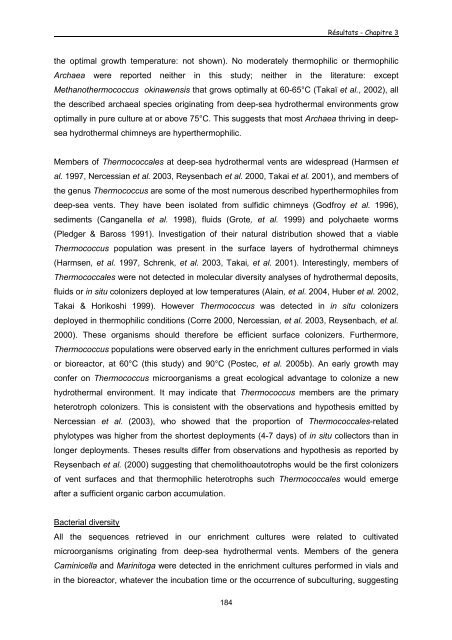THESE Anne POSTEC Diversité de populations microbiennes ...
THESE Anne POSTEC Diversité de populations microbiennes ...
THESE Anne POSTEC Diversité de populations microbiennes ...
Create successful ePaper yourself
Turn your PDF publications into a flip-book with our unique Google optimized e-Paper software.
Résultats - Chapitre 3<br />
the optimal growth temperature: not shown). No mo<strong>de</strong>rately thermophilic or thermophilic<br />
Archaea were reported neither in this study; neither in the literature: except<br />
Methanothermococcus okinawensis that grows optimally at 60-65°C (Takaï et al., 2002), all<br />
the <strong>de</strong>scribed archaeal species originating from <strong>de</strong>ep-sea hydrothermal environments grow<br />
optimally in pure culture at or above 75°C. This suggests that most Archaea thriving in <strong>de</strong>epsea<br />
hydrothermal chimneys are hyperthermophilic.<br />
Members of Thermococcales at <strong>de</strong>ep-sea hydrothermal vents are wi<strong>de</strong>spread (Harmsen et<br />
al. 1997, Nercessian et al. 2003, Reysenbach et al. 2000, Takai et al. 2001), and members of<br />
the genus Thermococcus are some of the most numerous <strong>de</strong>scribed hyperthermophiles from<br />
<strong>de</strong>ep-sea vents. They have been isolated from sulfidic chimneys (Godfroy et al. 1996),<br />
sediments (Canganella et al. 1998), fluids (Grote, et al. 1999) and polychaete worms<br />
(Pledger & Baross 1991). Investigation of their natural distribution showed that a viable<br />
Thermococcus population was present in the surface layers of hydrothermal chimneys<br />
(Harmsen, et al. 1997, Schrenk, et al. 2003, Takai, et al. 2001). Interestingly, members of<br />
Thermococcales were not <strong>de</strong>tected in molecular diversity analyses of hydrothermal <strong>de</strong>posits,<br />
fluids or in situ colonizers <strong>de</strong>ployed at low temperatures (Alain, et al. 2004, Huber et al. 2002,<br />
Takai & Horikoshi 1999). However Thermococcus was <strong>de</strong>tected in in situ colonizers<br />
<strong>de</strong>ployed in thermophilic conditions (Corre 2000, Nercessian, et al. 2003, Reysenbach, et al.<br />
2000). These organisms should therefore be efficient surface colonizers. Furthermore,<br />
Thermococcus <strong>populations</strong> were observed early in the enrichment cultures performed in vials<br />
or bioreactor, at 60°C (this study) and 90°C (Postec, et al. 2005b). An early growth may<br />
confer on Thermococcus microorganisms a great ecological advantage to colonize a new<br />
hydrothermal environment. It may indicate that Thermococcus members are the primary<br />
heterotroph colonizers. This is consistent with the observations and hypothesis emitted by<br />
Nercessian et al. (2003), who showed that the proportion of Thermococcales-related<br />
phylotypes was higher from the shortest <strong>de</strong>ployments (4-7 days) of in situ collectors than in<br />
longer <strong>de</strong>ployments. Theses results differ from observations and hypothesis as reported by<br />
Reysenbach et al. (2000) suggesting that chemolithoautotrophs would be the first colonizers<br />
of vent surfaces and that thermophilic heterotrophs such Thermococcales would emerge<br />
after a sufficient organic carbon accumulation.<br />
Bacterial diversity<br />
All the sequences retrieved in our enrichment cultures were related to cultivated<br />
microorganisms originating from <strong>de</strong>ep-sea hydrothermal vents. Members of the genera<br />
Caminicella and Marinitoga were <strong>de</strong>tected in the enrichment cultures performed in vials and<br />
in the bioreactor, whatever the incubation time or the occurrence of subculturing, suggesting<br />
184
















